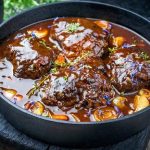We’ve all been there. While you’re making soup, you stop and take a taste. The soup seems too watery. You are disappointed and wonder “How can I thicken the soup to make it creamy?”
This guide will cover how to thicken soups or stews.
What makes a soup or stew thick and creamy?
Reminisce about the creamiest soups that you have ever tried. Cream of mushroom. Broccoli cheddar soup. Gumbo. These dishes were thickened with what ingredients? Some recipes include thickeners such as cream or flour. Some soups can be modified by using other techniques like pureeing and mashing.
You will need to choose the right thickener depending on your use case.
Six Ways to Thicken Soups and Stews
1. Puree the vegetables.
Pureeing the vegetables is the best way to thicken soup. The creamiest soups are made with starchy vegetables. You can use potatoes, corn, parsnips and sweet potatoes. For a more chunky texture, blend half of the vegetables with the liquid.
2. Mash beans, lentils and rice are all good options.
A great way to give your soup more body is to mash beans, lentils or rice. Cannellini beans and red lentils, as well as yellow lentils and white rice, add great flavor to your soup. You can also mashing half of the cooked beans/lentils/beans to thicken the soup.
You can also blend half of the soup or all for a smoother texture.
When making bread, remove the crusts and add cubes of the soup’s soft interior. For a uniform texture, you can puree the soup.
3. You can also add some dairy.
Your dish will have a velvety texture thanks to dairy products. While soups thickened with milk won’t have the same weight as pureed vegetables, they will be rich and creamy. Dairy also helps to balance a spicy dish. The bright contrast of yogurt and buttermilk is provided by buttermilk and yogurt.
When dairy is added incorrectly, it can curdle liquids. Avoid this risk by using cream or crème fraiche, which have higher fat content. Low-fat products like milk can curdle when heated. So add them to the soup as soon as it is warm, but not boiling.
Tempering can also reduce curdling. Start by adding a small amount to the dairy. Continue whisking the soup until it reaches the desired temperature. Next, add the milk mixture to the soup and whisk it at low heat.
Some recipes may call for flour or cornstarch to be used with milk or yogurt. These stabilizers lower the risk of curdling.
Add cream to soup. Slowly stir the cream into the soup over medium or low heat. The cream should not curdle if it is heated at a lower temperature, but it is possible to temper it to ensure safety. Coconut milk is a great dairy-free option, but high temperatures can cause it to curdle.
You can add yogurt or buttermilk to a soup, such as gazpacho. Buttermilk and yogurt can be added to the soup. Alternately, temper the milk and then heat the soup on low heat.
4. Add an egg.
It is possible to thicken liquids by adding eggs. This is common with avgolemono which is a creamy lemon soup. Mix eggs with the hot liquid. Once the egg mixture is at the right temperature, temper it by adding small amounts to the soup. Slowly stir the egg mixture into the soup. Do not boil it or it will curdle.
5. Mix in some flour or starch.
Starches and flours both help thicken sauces. They will clump if they are added directly to your soup. Instead, mix a small amount soup with the starch or flour to dissolve it, and then add the mixture to the soup.
This mixture is also called a “slurry”. Let the soup boil for about a minute after adding the slurry. The mixture may thin again if it is boiled for too long.
A roux is another way to thicken soup, as in making gumbo. A roux, a paste made from flour and fat, is a cooked paste. Similar methods are used in a beurre manie. This involves mixing butter and flour until it forms a paste. Once the paste has been incorporated, it is whisked into a soup. To thicken the soup properly, you will need to boil it. To prevent clumping, a roux should be added to a cold liquid.
6. Add some silken tofu.
Silken tofu, which is dairy-free, has a neutral flavor. Blend the silken soup base with the silken tofu until smooth.
Equipment Recommendations
You will need to mix, mash, or purée ingredients for many thickeners. A whisk is useful for smooth mixing starches and flours in soup. You can also use a potato masher to mash starchy vegetables like beans and lentils.
The right equipment for blending depends on what consistency you are looking for. An immersion blender, for example, is very useful to blend soup on the stove. However, it can be difficult to achieve a smooth soup.
A countertop blender will give you the smoothest texture. Blending hot foods in a countertop blender is dangerous. Before adding the liquid to the blender, cool it down. Then, take off the feeder cap and place a towel on top of the hole. Otherwise, hot liquids can explode. While blending, keep your hand on the towel. Continue to blend at low speed until the mixture becomes smooth.



